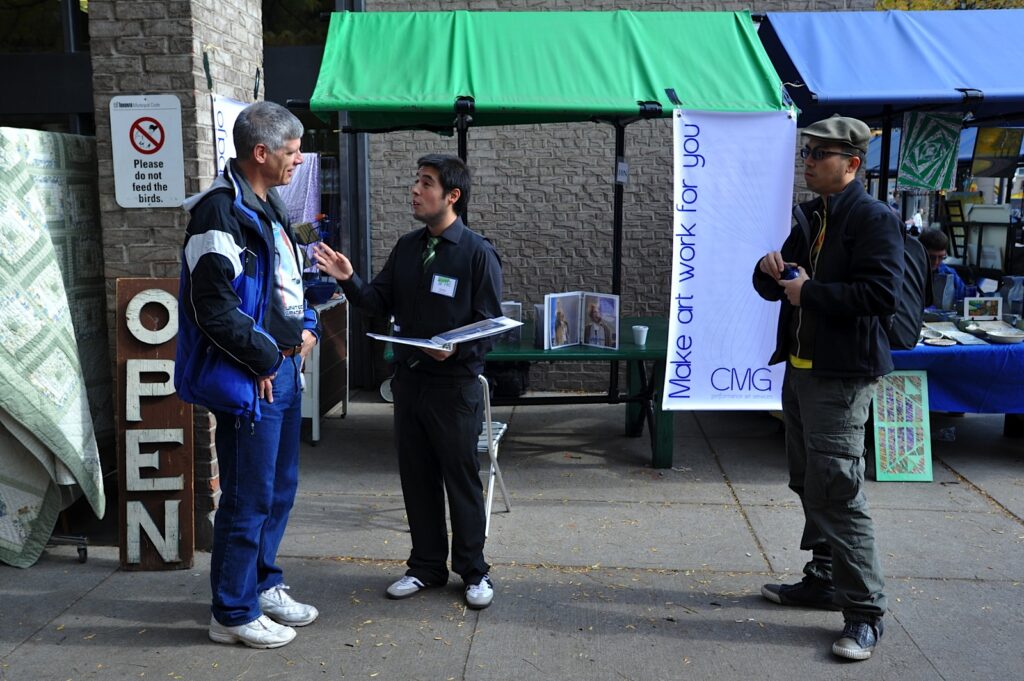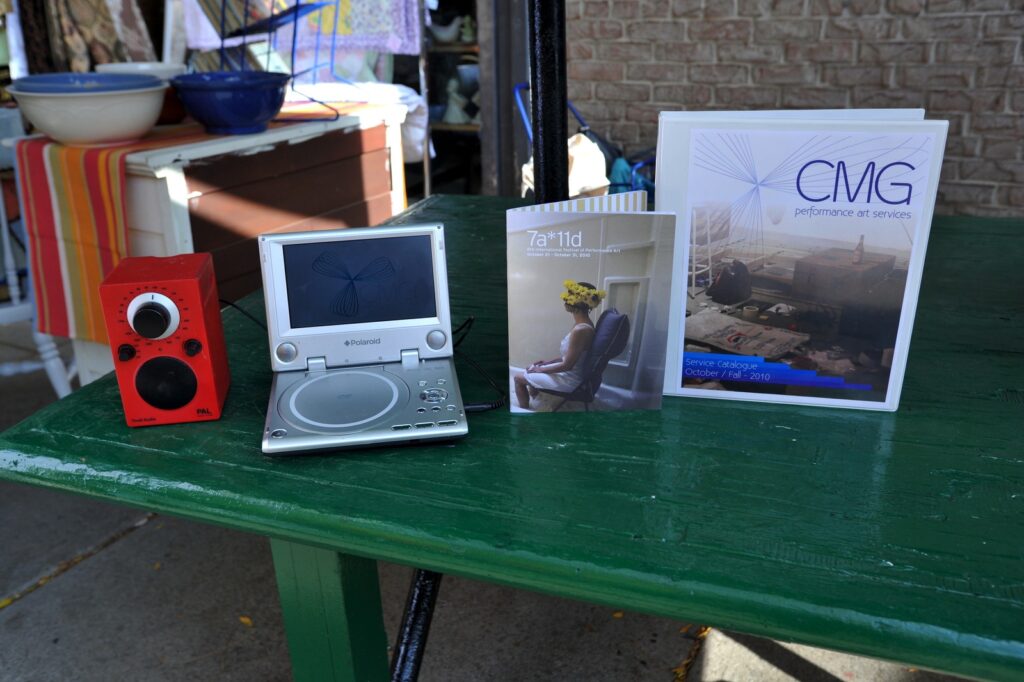By Natalie Loveless
I approach the St. Lawrence Street Market from Union Station. It is slightly chilly on this second to last day of the festival. I am looking for the CMG Performance Art Services booth, which has been described to me as an organization by and for artists, figure-headed by Colombian artist Carlos Monroy, that promises to make performance art more economically accessible while giving performance artists a regular source of income. I am intrigued…
First I see the banner, large, blue on white: Make Art Work For You. As I arrive, I see Monroy deep in conversation with a passer-by. I listen in while looking over the booth wares: a corporate video advertizing the company and a service catalogue complete with mission statement and corporate logo. As I peruse the catalogue, looking over work—work that I can presumably purchase, though it is still opaque to me exactly how such a purchase might operate—I hear Monroy extolling the value of performance art and art more generally for the good of the demos. A family of four visiting from India nod in agreement, particularly the father, who launches into a story about the appalling public support for the arts in his hometown and the difficult fate of his brother, a sculptor. While Monroy encourages the whole family to join his service, I turn back to the catalogue and video.
In both, the work for sale is separated into four categories: Temporary and Ritualistic; Public Spaces; Minimalistic and Formalstic; Identity Issues Related; Institutional Critique. I am leafing through a performance art library ready to be bought and sold for my aesthetic pleasure. Looking for something to brighten up your corporate retreat this year? Purchase some performance art, all tied up in a lovely corporate bow. It seems difficult not to read the stall as a send-up, especially when watching the corporate video playing on loop at one end of the performance booth. Over and over again the video intones: We are artists thinking about how to help other artists be creatively and economically successful without sacrificing the real soul of what makes performance art.… We are contemporary, vibrant, aggressive and ownable…. We offer a truly here and now experience…. We are confident, dynamic, versatile… Instead of trafficking in the buying and selling of objects we focus on the context in which the action is happening…
CMG Performance Art Services is sold as a brand identity. However, while not completely convincing as a business pitch, it works as satire. As I lean in, I could be listening to an articulate and vibrant aunt trying to sell me a pitch from a pyramid kit she ordered over the internet in order to get her home-business off the ground. It has both that kind of zeal and fragility. Monroy begins (I paraphrase): Performance artists normally sell pictures and videos of performance work as documentation. This is their only long-term access to an artistic commodity circuit. We at Performance Art Services insist that liveness is lost with these practices. Instead, we propose selling the performance itself, as a propositional co-authored construct! While it might look like what is being sold is the script of the performance, we assert that it is instead the soul of liveness that we traffic in. We do this by insisting that each iteration is a new one, a collaboration between the original author of the piece and a local performer. We don’t re-produce, we don’t re-do, we engage in a co-authorship, co-writing practice.
Furthermore, Monroy continues, CMG Performance Art Services is, like many contemporary businesses, committed to public outreach and education. In categorizing the product into “five styles of performance,” the public is invited to think about an anatomy of performance art. To recognize genre distinctions within a notoriously difficult to understand artistic form. Bringing performance art into the streets and homes and corporate corners of the world—in Monroy’s words, bringing it to the “real public,” that is, to people who don’t already know how to think about performance art—CMG Performance Art Services argues that by co-opting the well-known Multi-Level Marketing business model made famous by housewives flocking dishware and makeup, all performance artists can make a living wage
With Joseph Beuys’s famous dictum “everyone is an artist” as the ground of his project, he asks each passerby to join the flock, believe in the cause, and network—for a small fee—in the name of performance.




